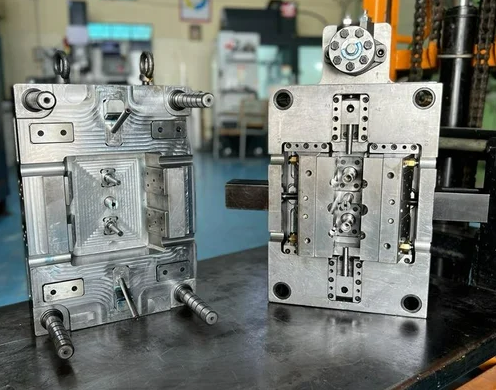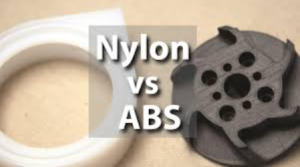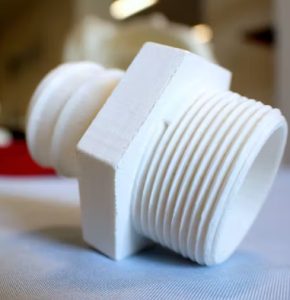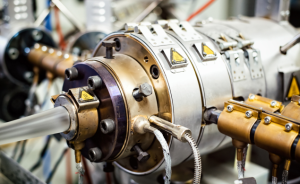Injection molds are essential tools in the plastic manufacturing process, and they come in various types designed to meet different production needs and product specifications. Here’s an overview of the primary types of injection molds:
1. Two-Plate Mold
Description:
- Structure: Consists of two main plates: a stationary (cavity) plate and a moving (core) plate.
- Function: The molten plastic is injected into the mold cavity, and the part is ejected once it cools and solidifies.
Applications:
- Simple Parts: Ideal for basic, single-material parts without complex geometries.
- General Use: Commonly used for a wide range of plastic products.
2. Three-Plate Mold
Description:
- Structure: Includes an additional plate (runner plate) between the stationary and moving plates.
- Function: The runner system is separated from the part, allowing for easier ejection and better control over gate location.
Applications:
- Complex Parts: Suitable for parts requiring multiple gate locations or complex geometries.
- Improved Quality: Provides better control over part filling and reduces defects.

Choose us for your custom injection molding needs and experience excellence in every detail. Our China-based factory provides innovative solutions, competitive pricing, and fast turnaround times. Get your custom quote now!
3. Hot Runner Mold
Description:
- Structure: Incorporates a heated manifold system that keeps the plastic in a molten state as it travels through the runners.
- Function: Eliminates the need for cold runners, reducing waste and improving cycle times.
Applications:
- High-Volume Production: Ideal for large production runs where minimizing waste and cycle time is critical.
- High-Quality Parts: Reduces gate marks and enhances part aesthetics.
4. Cold Runner Mold
Description:
- Structure: Uses traditional runner systems where the plastic solidifies in the runner and is ejected with the part.
- Function: More straightforward design compared to hot runner molds, but generates more waste.
Applications:
- Low to Medium Volume: Suitable for smaller production runs where cost savings on mold complexity are desired.
- Simple Parts: Often used for less complex parts where material waste is not a primary concern.
5. Stack Mold
Description:
- Structure: Features multiple parting lines with two or more mold cavities stacked vertically.
- Function: Increases the number of parts produced per cycle without requiring larger injection molding machines.
Applications:
- High-Volume Production: Ideal for producing large quantities of parts in a single cycle.
- Efficient Use of Space: Maximizes the output while minimizing the machine’s footprint.
6. Family Mold
Description:
- Structure: Contains multiple cavities of different shapes, allowing different parts to be molded simultaneously.
- Function: Produces different parts in one cycle, reducing setup times and costs.
Applications:
- Multi-Component Assemblies: Useful for producing sets of related parts that will be assembled together.
- Cost-Effective: Reduces the need for multiple molds and machine setups.

As a leading mold injection manufacturer in China, we deliver superior molds for various industries. Our state-of-the-art facilities and expert team ensure top-notch quality and timely delivery. Contact us now for a competitive quote!
7. Insert Mold
Description:
- Structure: Designed to accommodate pre-formed inserts (metal or plastic) that are placed into the mold before injection.
- Function: The plastic material is injected around the insert, bonding it to the part.
Applications:
- Hybrid Parts: Used for producing parts that combine plastic with metal or other materials.
- Enhanced Properties: Adds strength, conductivity, or other functional properties to the plastic part.
8. Unscrewing Mold
Description:
- Structure: Incorporates a mechanism to unscrew threaded parts from the mold.
- Function: Allows the creation of parts with internal or external threads without damaging the part during ejection.
Applications:
- Threaded Components: Ideal for parts like bottle caps, threaded connectors, and other items requiring precise threads.
- Complex Designs: Suitable for parts that cannot be ejected with standard methods.
9. Gas-Assisted Mold
Description:
- Structure: Uses a controlled injection of gas (usually nitrogen) into the molten plastic to create hollow sections.
- Function: Reduces material usage and weight while maintaining structural integrity.
Applications:
- Lightweight Parts: Used for making lightweight and structurally sound parts like handles, frames, and large panels.
- Reduced Sink Marks: Helps eliminate sink marks in thicker sections of parts.

Choose us for your custom injection molding needs and experience excellence in every detail. Our China-based factory provides innovative solutions, competitive pricing, and fast turnaround times. Get your custom quote now!
10. Multi-Shot (Two-Shot) Mold
Description:
- Structure: Designed to inject two different materials or colors sequentially into the same mold.
- Function: Allows the creation of multi-material or multi-colored parts in a single molding cycle.
Applications:
- Complex Parts: Ideal for parts requiring different materials for functionality or aesthetics.
- Enhanced Features: Useful for adding soft grips, over-molded gaskets, or visual effects.
Conclusion
Selecting the right type of injection mold depends on the specific requirements of your production, including part complexity, volume, material, and cost considerations. Understanding the capabilities and applications of each mold type will help in making an informed decision that optimizes production efficiency and part quality.
Related Conten: Prototype Injection Molding






